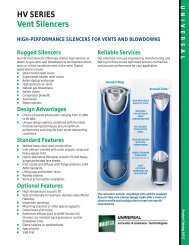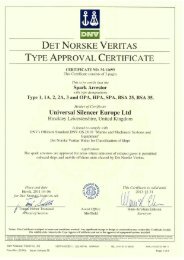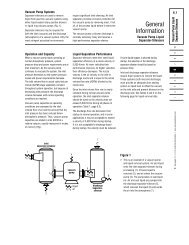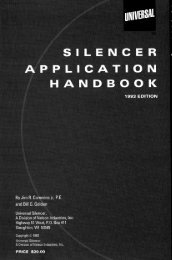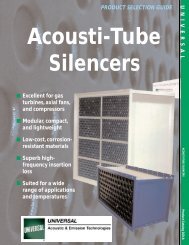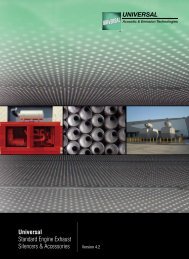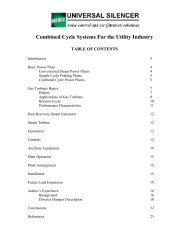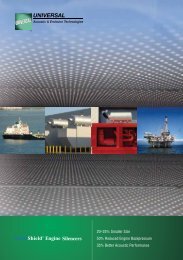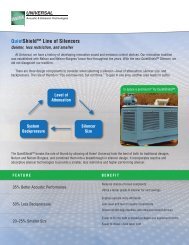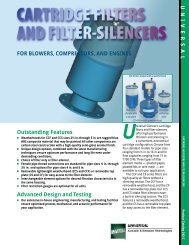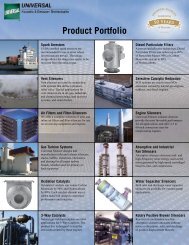Blower Silencers - Technical Literature - Universal: Acoustic Silencers
Blower Silencers - Technical Literature - Universal: Acoustic Silencers
Blower Silencers - Technical Literature - Universal: Acoustic Silencers
Create successful ePaper yourself
Turn your PDF publications into a flip-book with our unique Google optimized e-Paper software.
In a closed blower discharge system,structure-borne noise—such as that radiatedby pipe wall and silencer shell—may be aconsideration, particularly where a stringent,close-proximity noise specification applies.For these applications, various means are availableto treat the pipe and shell radiated noise, such thatmost reasonable specifications may be met.For instance, it is possible to lag the silencer shellexternally and reduce any shell noise contributionto below the casing and mechanical noise of theblower and driving machinery.<strong>Universal</strong> invites your inquiries concerningspecial applications where EPA, OSHA or othernoise specifications apply. Special applicationsare handled on an individual basis andrecommendations are made according tospecific requirements of the installation.GeneralInformation<strong>Blower</strong> <strong>Silencers</strong>Rotary Positive <strong>Blower</strong>sThe Rotary Positive <strong>Blower</strong> is a two impellercompressor that delivers a large quantity of gasor air relative to the individual pulses. <strong>Blower</strong>capacities are expressed in CFM at inlet conditions(ICFM). <strong>Blower</strong> size is usually expressed as geardiameter by rotor length. Pitch Line Velocity (PLV)is the peripheral velocity of the timing gear—equalto the product of the gear circumference and therotative speed of the blower, usually expressed infeet per minute (FPM).The blower presents two problems:1) pulsation within the piping system and,2) noise radiation in the vicinity of the blowerand piping.The importance of these relative to each other is afunction of blower size and speed; both increaseproportionately to the blower size and the squareof the speed.Pulsation is more pronounced on the dischargeside. Peak pulse pressures are quite severe andcan result in unsilenced discharge sound powerlevels up to 140–145 dB. The inlet, althoughproducing less severe pulsation and noise, receivesequal attention since the inlet is usually open toatmosphere and the noise much more apparent.<strong>Silencers</strong>There is little question that silencers are a necessityon any blower installation. Regardless of the sizeor speed of the blower, silencers of some type arenearly always used.In the selection of blower silencers, there are twobasic considerations: 1) the silencer must be thecorrect size (i.e., sufficient capacity for the volumeflow) and, 2) the silencer must be the propertype for the application. The nominal silencersize need only be based on the gas volume,(i.e., the CFM of the gas or air at the operatingconditions). However, the silencer (design) must beselected with consideration of the blower size andoperating speed. Complete application and capacityinformation is given on page 3.There are two types of silencers commonly usedon positive blowers: a reactive type silencer whichconsists of a series of expansion chambers havinginterconnecting tubes, a more sophisticatedsilencer design. is the combinationchamber-absorptive type. This combination silenceris similar to the reactive type with the exceptionthat an acoustically-packed, sound absorbingsection is included, comprising an extension of thesilencer connection closest to the blower. The inletof a discharge silencer and the outlet of an inletsilencer are the ends having the packed section.A third basic type of silencer—the simple,straight-through packed type—is occasionally usedon blowers. This type of silencer is usually used onsmall, high speed machines which characteristicallyproduce significant high frequency noise andrelatively mild pulsations.The PLV is normally the criterion for silencer typeselection. If the blower is operating in the criticalPLV range, it will generate objectionable highfrequency noise which may cause shell ring or tankhammer in the piping and silencer. These criticalPLV conditions will always require a combinationchamber-absorptive silencer for satisfactory results.Inlet <strong>Silencers</strong>For inlet service, a PLV of 3,300 ft/min or greateris considered critical. This transition speed isempirically established and is somewhat arbitrary,however, it is commonly accepted that blowersoperating at or above 3,300 ft/min are consideredcritical for the purpose of inlet silencer application.Those operating below 3,300 ft/min are consideredsubcritical. Subcritical PLV applications canusually be silenced adequately with a chambertypesilencer, such as <strong>Universal</strong> URB or UCISeries. <strong>Blower</strong>s operating above the critical PLV of3,300 ft/min will invariably require the RIS Seriescombination chamber-absorptive type silencer. InletFilters or Filter <strong>Silencers</strong> are commonly used onblower inlets, either individually or in series with aseparate inlet silencer. Please reference Filters andFilter <strong>Silencers</strong> <strong>Technical</strong> <strong>Literature</strong> booklet#94-1553.Discharge <strong>Silencers</strong>For the more severe discharge conditions of typicalblower installations, a PLV of 2,700 ft/min isaccepted as the critical transition speed. <strong>Blower</strong>soperating below 2,700 ft/min are consideredsubcritical and can usually be adequately silencedon the discharge side by use of a chamber-typesilencer UCD or URD Series. Machines operatingabove the 2,700 ft/min transition speed will requirecombination chamber-absorptive silencers such asSD or RD Series.In some larger blower installations, pipingrequirements or space restrictions may precludethe use of a large, single discharge silencer such asthe SD or RD Series.Where two or more blowers discharge into acommon header, individual silencers upstream ofthe header are required to subdue the individualblower pulsations. Otherwise, the pulsations tendto beat with each other and can be extremelyobjectionable.Note: <strong>Silencers</strong> should be mounted as close to theblower as possible since any piping between theblower and silencer will radiate noise. Standardsilencer connections are not designed to carryexternal piping or valve loads, so good pipingsupport practices should be used to preventstresses that cause fatigue and eventual fractureof the silencer or piping. It is also good practice toisolate the blower from the silencer with a flexibleexpansion joint. Contact <strong>Universal</strong> for specialdesign considerations where loading is a factor.Attenuation CurvesNoise attenuation curves are given for the variousmodels within this catalog.The curves represent insertion loss of airbornenoise for typical applications under averageconditions. It is not feasible to chart the expectedperformance of a silencer over a wide range ofapplications and conditions, therefore, the curvesmust be used with discretion. Structure-bornenoise (see above) may be a consideration and willrequire separate analysis, since it is not airbornenoise and not used for silencer performance rating.Use our online <strong>Blower</strong> Silencer calculator atwww.universalAET.com.© 2011 <strong>Universal</strong> <strong>Acoustic</strong> & Emission Technologies, Inc. All rights reserved.Toll-Free: 1-888-300-4272www.universalAET.com94-1547 Rev 01



